If you have been a dog owner for a long time, you have probably encountered certain health problems with your pet. If one of these problems was red testicles in your male dog, we are sure you were pretty worried.
This article is intended for those owners who may be wondering why dog’s balls are red, and for all dog lovers to get general information about this phenomenon.
When you know at least the fundamental causes of a problem, you can help your pet and explain your dog’s health condition to the vet in detail.
A dog’s testicles can turn red for a variety of reasons. We won’t delay the introduction, so let’s get straight to the point.
Why Dog’s Balls Are Red?

Why are my dog’s balls are red? Is there something wrong with my furry friend?
Before you think the worst, we advise you to be well-informed first. Red testicles in a dog can indicate various health conditions, but don’t forget: the sooner you find out the exact cause of this condition in your dog, the sooner you can help your furry friend.
Let’s see what the common causes of red dog’s testicles are.
1. Trauma
Your dog probably loves to play, jump, and explore his surroundings. It is not unusual for a dog to get injured during these activities.
You must have noticed a wound or a cut somewhere on your dog’s body at least once.
An injury can also be the reason why your dog’s scrotum has turned red. It would be best to examine the dog’s testicles yourself and check if they are bleeding or have visible cuts.
If you see that the dog is in great pain while you are trying to examine him, visit the veterinarian immediately. Some injuries can be harmless, but some can be very dangerous for the dog’s health.
2. Allergies
An allergic reaction could be the cause of the dog’s red testicles.
An allergic reaction in a dog can be caused by various foods, but also by contact with allergens such as cleaning products, shampoos, or pollen.
First, it is necessary to determine what exactly caused the dog’s allergy, and then consult with a veterinarian on how to treat the allergy.
Therefore, both dogs and people can suffer from allergies and skin rashes can be noticed on all parts of the dog’s body.
3. Sunburn
Did you know that dogs can get sunburned too? A dog’s nose can turn red from sun exposure, but so can his testicles!
Dog skin is generally very delicate, and especially sensitive parts of the body are the muzzle, lips, and testicles.
Do you like to enjoy a sunny day outside with your favorite pet? Great, because your dog most likely enjoys it the same way! But, remember to apply sunscreen to your dog. Short-haired dog breeds and dogs with light fur are especially exposed to sunburn.
4. Excessive Licking
We all know our dogs love to lick all kinds of things. Many dogs often lick their lips, but some of them lick their balls! What is going on? Is there something wrong with your dog?
Dogs sometimes lick their testicles just like any other part of their body. Simply said – this behavior is in dog’s nature.
If you didn’t notice swollen testicles or any other sign of sickness in your dog, maybe his balls got red simply because the dog licked them excessively.
However, there is probably a good reason behind this excessing licking. Maybe your dog is bored, anxious, or unhappy. Please pay attention to your dog’s behavior and ensure he receives enough physical and mental stimulation.
5. Insect Bites
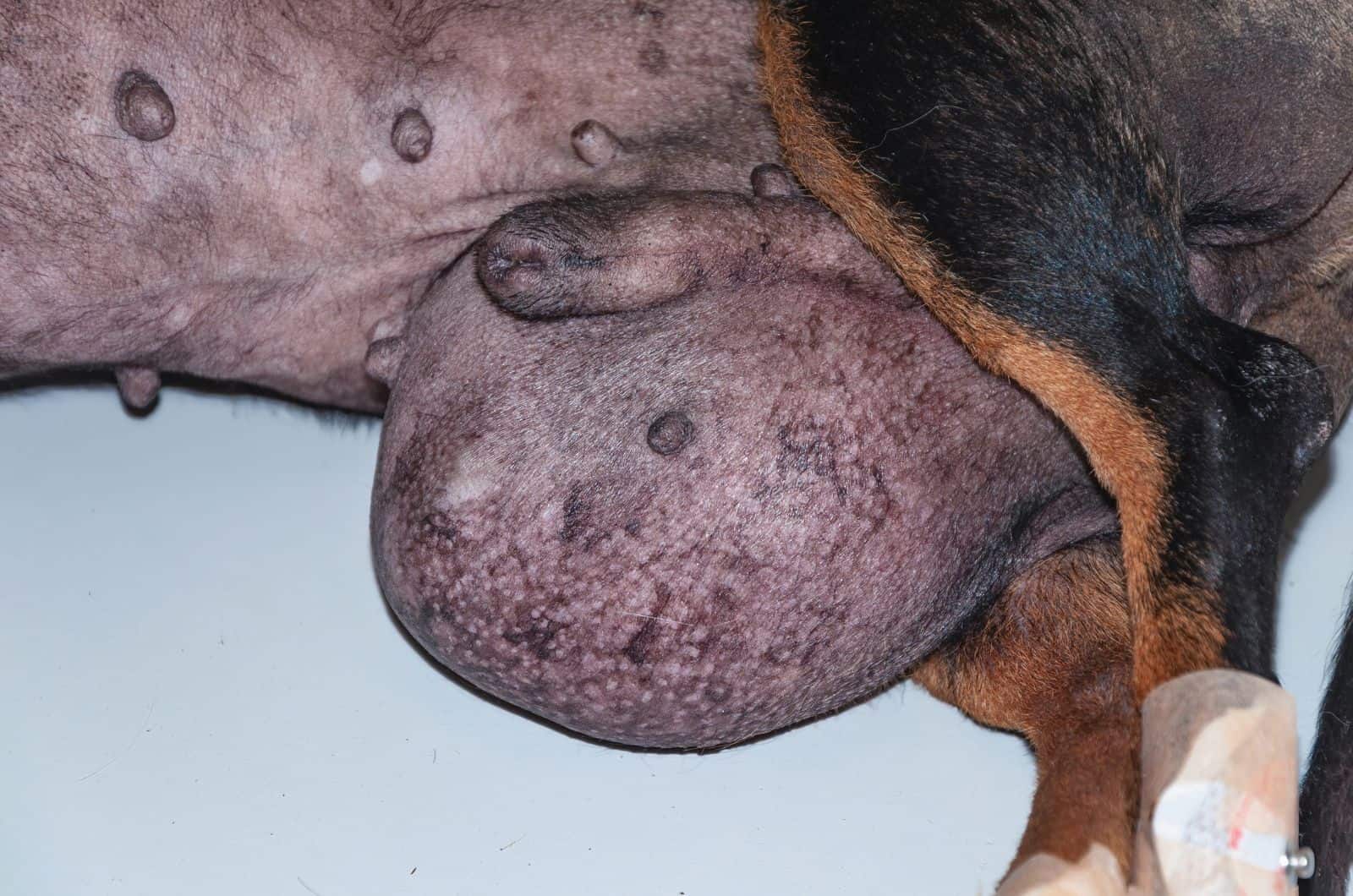
Red testicles in dogs can sometimes occur due to insect bites such as fleas. If a flea bites your dog, you will notice itchiness and redness.
If the dog constantly licks the genitals, it is most likely an insect bite.
Along with redness and scratching, it is also possible that the dog will start to lose hair, and its skin will be irritated. Flea bites are not harmless, as the dog can even become anemic if the fleas drink too much of his blood.
If you suspect fleas, check your dog’s gums. If the dog’s gums are very pale, it is definitely due to fleas. Learn more in our article on dog gum color chart.
The veterinarian will advise you on the best way to deal with fleas.
6. Scrotal Hernia
A scrotal hernia in a dog refers to the enlargement of the inguinal canal, which creates the possibility of spillage of abdominal contents through the canal or opening in the dog’s groin.
The inguinal canal is an opening in the muscle wall in the dog’s groin, and its function is to allow cords and blood vessels to pass to the dog’s testicles.
If the opening of this channel widens, a scrotal hernia occurs. As a result, symptoms such as red and swollen testicles, pain, bloody urine, and vomiting, lack of appetite, and depression in the dog appear.
In some cases, a scrotal hernia is inherited genetically, and sometimes it can occur due to injury or obesity of the dog.
7. Testicular Torsion
One of the medical problems that could cause red eggs in a dog is testicular torsion. This condition involves rotation of the spermatic cord in the dog, which means that the dog’s testicles are not sufficiently supplied with blood. So, this condition blocks blood flow in dog’s balls.
Together with red testicles, you may notice swollen testicles and scrotal pain in a dog with this medical problem. In addition, the dog may have a fever, and may refuse to walk, or even not want to eat.
Neutering a dog can prevent torsion of the testicles. If the dog is diagnosed with testicular torsion, the veterinarian will prescribe antibiotic therapy, or a surgical procedure to remove one or both testicles.
8. Sexually Transmitted Diseases
Unfortunately, our dogs can also get sexually transmitted diseases.
The most common venereal disease in dogs is Brucellosis, which is caused by the bacterium Brucella canis. This disease is transmitted by contact with the fluid of an infected dog or by sexual intercourse with an infected dog.
Inflammation of the testicles is one of the signs of this venereal disease in male dogs, while in female dogs this venereal disease is more difficult to notice. This disease is also transmissible from a dog to a human, and is treated with antibiotic therapy.
If left untreated, Brucellosis can even cause infertility in dogs. Therefore, if you notice red and inflamed testicles in a dog, and know that your dog has been sexually active, it is necessary to take him to the vet immediately.
9. Orchitis
Orchitis is an inflammation of the testicles, which can occur in dogs due to various causes, such as an injury, or as a result of distemper, bacterial infection, or a fungal infection. This inflammation causes red and enlarged testicles and pain in the dog.
There is acute and chronic inflammation of the testicles. Painful and hard testicles manifest acute inflammation, and you may also notice walking difficulties and fever in your dog. Learn more information on fever in our article on dog temperature chart.
Veterinarians prescribe antibiotic treatment for acute inflammation of the testicles. In addition, it is useful to apply cold compresses to inflamed testicles.
Unlike acute inflammation, chronic testicular inflammation is incurable. Orchitis significantly affects a dog’s fertility, so veterinarians usually prescribe castration of a dog with testicular inflammation.
One similar condition in dogs that can also cause red and swollen testicles is epididymitis, which is an inflammation of the testicular tube or epididymis in dogs.
10. Testicular Tumor
Red balls can in some cases indicate a tumor in a dog. Testicular tumors most often affect dogs around 10 years of age, or older.
Tumors can be benign or malignant. Malignant tumors spread to other organs and surrounding tissues, while benign tumors do not metastasize surrounding healthy tissue.
The most common tumors that occur on the testicles are seminoma and testicular cancer. Apart from redness, enlarged testicles are another symptom of testicular tumors.
Treatment will depend on the type of tumor, involvement of the surrounding area, and dog’s age. Some dog breeds such as German Shepherds, Rottweilers, and Golden Retrievers are more prone to develop different tumors.
The veterinarian will make a diagnosis after a clinical examination. The basic treatment for all forms of testicular tumors is castration. If only one testicle is affected, a vet might suggest removal of only that testicle.
What Color Are Dog Balls?
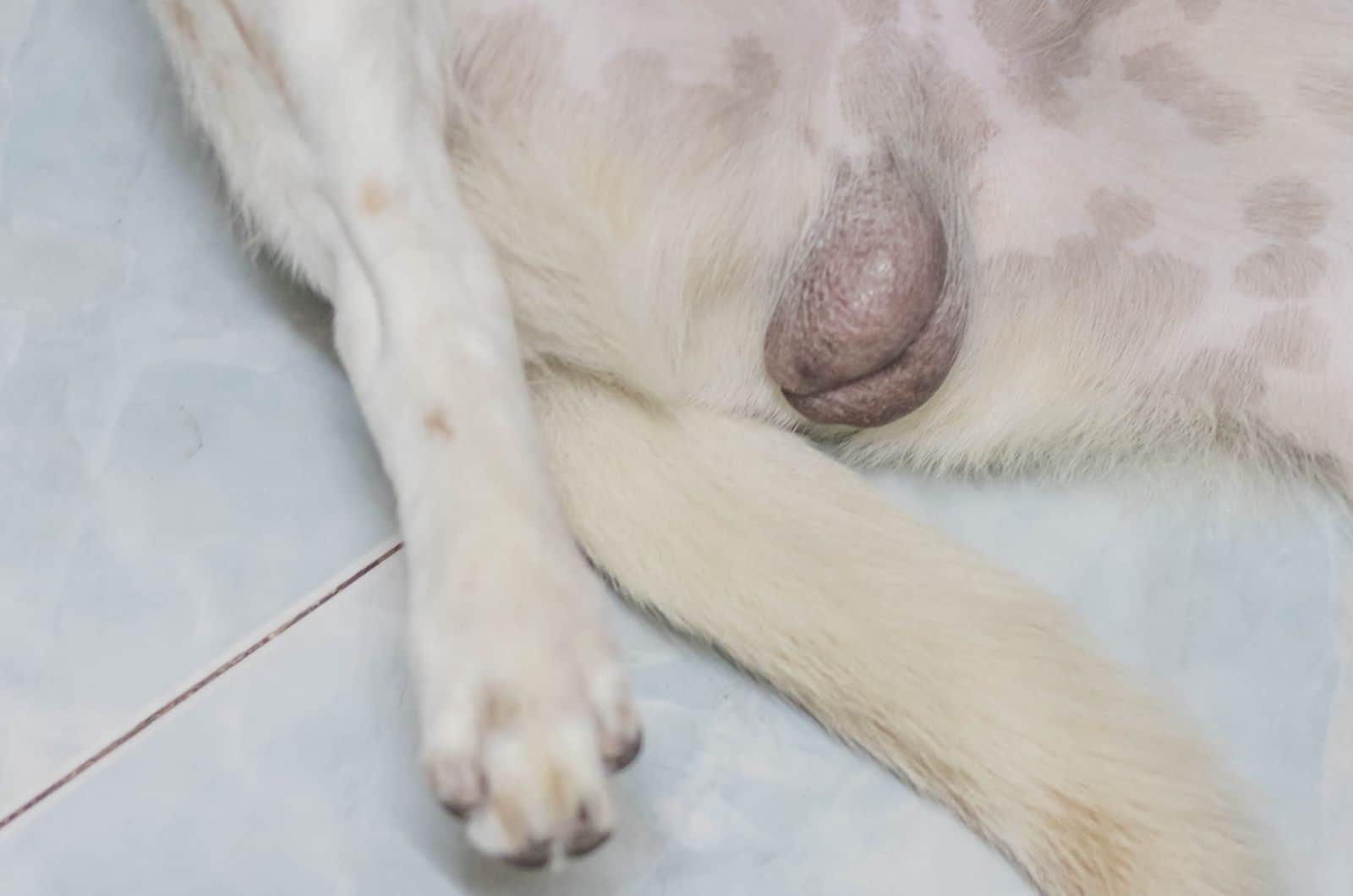
As a rule, the testicles of a healthy adult dog should be grayish, and the color of the testicles does not depend on the color of the dog’s fur.
However, some dogs have slightly darker testicles, which is not a warning sign. Also, some younger dogs may have pink spots on the scrotum, which is entirely normal.
As a dog ages, the pigmentation of its skin changes, so some parts of its body may lose color or change color. For this reason, older dogs sometimes have dark spots on their testicles.
As we have seen, red testicles in dogs occur due to various medical conditions. Therefore, you must react immediately as soon as you notice that your dog’s testicles have changed color.
What Should I Do If My Dog’s Balls Are Red?
The first thing any concerned dog owner asks after noticing that their dog has red testicles is surely: Is there anything I can do to help my dog?
Of course there is – every problem has a solution! Health problems require veterinarian assistance, but you can also take some steps before visiting the vet.
1. Pay Attention To Dog’s Activities
As we mentioned earlier, in some cases the dog can lick the testicles excessively which can cause them to turn red. If it is not a health cause, a dog can lick his balls to such an extent for various reasons.
Pay attention to your dog’s daily routine. How much exercise does your dog get? How much time do you spend playing with him? Does your dog have company or is he often lonely?
Many dogs suffer from separation anxiety. If you recently left your puppy alone at home for the first time, he may have had a hard time taking it. The result of this anxiety can be destructive behavior, but also intense licking of the testicles.
If your dog is physically active enough, it may be a lack of mental stimulation. Maybe your dog is tired of being in the same place all the time.
Consider giving him some new toys to play with. You can also make his ordinary feeding routine interesting by buying him a new food container with compartments.
In this way, the dog will struggle a bit until he gets to the food he loves – so he will be mentally engaged and eating his favorite food simultaneously.
There are many ways that every dog owner can make everyday life more interesting for their dog. They don’t even require much effort, and the results will probably blow your mind!
2. Importance Of Dog Food
Allergies in dogs can cause red testicles. In addition to environmental allergens, dogs can also be allergic to food. You probably sometimes share your meal with your dog, but you should do this sparingly.
You can’t tell if a dog will have an allergic reaction to an ingredient in food that people eat.
A dog can also be allergic to certain dog food, and if this is the case, it will be necessary to find a food that will suit your pet entirely.
To determine what exactly is causing your dog’s allergic reaction, you will need to perform the necessary tests at a veterinarian.
3. Try Home Remedies
Before you start panicking about what medications your dog will need to get his testicles back to normal, you can try applying some preparations to his testicles and the surrounding area.
Preparations such as antibiotic ointment, Vaseline or Aloe Vera could prove to be very useful. They are non-toxic and will not harm your dog. It is possible that, in this way the dog’s testicles and scrotal skin will be hydrated, and the redness will subside.
It would help if you did not try to treat your dog with any other remedies on your own. However, home remedies like these two will not cause any additional damage to your dog’s testicles.
4. See A Vet
Caring for your dog involves regular vet visits. In addition to regular visits, you should contact the veterinarian immediately if you have any doubts about your dog’s health.
Red balls in a dog can clearly indicate various health conditions. The veterinarian will assess whether treatment in antibiotics or perhaps surgery will be necessary.
What you need to do is come prepared for the examination. You will need to give the vet all the details about your dog’s condition.
So, you will have to explain to him when you first noticed the red testicles, whether other symptoms are present and whether the dog is in pain. Your observations could be of great help to the vet in establishing a diagnosis.
More You Should Know On Dog’s Testicles
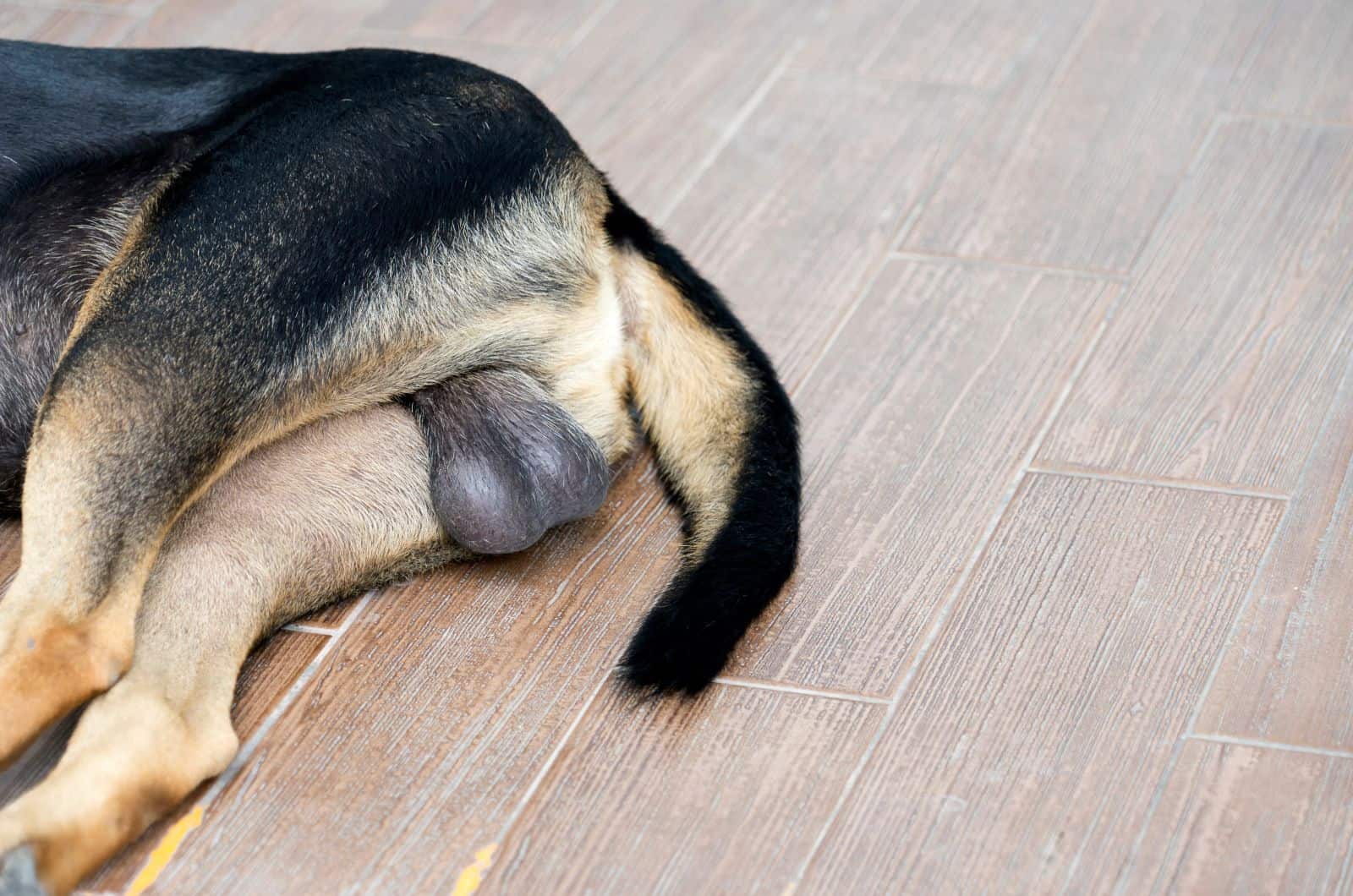
The testicles are one of the parts of the male sex organ of the dog. A dog’s testicles are located in the scrotum, under the tail, that is, in the perianal region. The basic function of the testicles in dogs is to secrete testosterone and produce sperm.
When puppies are born, their testicles are located in the abdominal cavity. If everything is normal, when the dog is 7 to 10 days old, its testicles descend into the scrotum.
However, this can also take a longer time, so in some dogs, it is only at the age of 6 months that you can notice that his testicles have completely descended.
There is also a condition when one or both testicles remain behind in a dog’s abdominal cavity, called Cryptorchidism.
Cryptorchidism
Cryptorchidism means the retardation of one or both testicles in the dog’s abdominal cavity. As we previously explained, testicular descent begins when the dog is only a few days old.
In most dogs, the testicles will be fully descended between 8 and 12 weeks of age, but in some dogs, it will take much longer for the descent to be complete.
Many dog owners are shocked to find their dog’s testicles appearing, then disappearing again. This is not so unusual, since testicles are very small and movable in young dogs.
The appearance and disappearance of the testicles is especially noticeable when the dog is excited or frightened, so his testicles are pulled towards the inguinal canal.
A dog can be said to have Cryptorchidism when it is 6 months old and his testicles have not descended. An undescended testicle can cause several health problems in a dog, so veterinarians usually advise removal of the undescended testicle.
Certain dog breeds, such as Maltese, Pekingese, Toy Poodles, and Yorkshire Terriers are more susceptible to an undescended testicle. If the dog has one residual testicle, it is still fertile and can reproduce. However, dogs with two retained testicles are usually unable to breed.
However, dogs with both testicles left behind still show sexual drive.
In some cases, it is possible to keep the remaining testicle functional with hormone therapy. This is recommended while the dog is still very young, up to 3 or 4 months of age.
Should You Neuter Your Male Dog?
Dogs usually start to show sexual curiosity at the age of 4 or 5 months.
During this period, changes in the dog’s behavior are clearly visible due to changes in its hormones. Also, you will notice clear signs that your male dog wants to mate. The dog will probably wander around looking for females all the time.
Also, marking the territory with urine will be noticeable, and you will probably often notice your dog licking his genital area and humping female dogs. Besides female dogs, a male dog who wants to mate is likely to hump all kinds of things, you, or even the air!
Behavior like humping can be very irritating and embarrassing for any dog owner.. During this period, it would be good to distract the dog with toys and other new activities. However, the only way to somewhat control this behavior is by neutering the dog.
Neutering is the procedure whose purpose is to remove the dog’s testicles.
Benefits Of Neutering
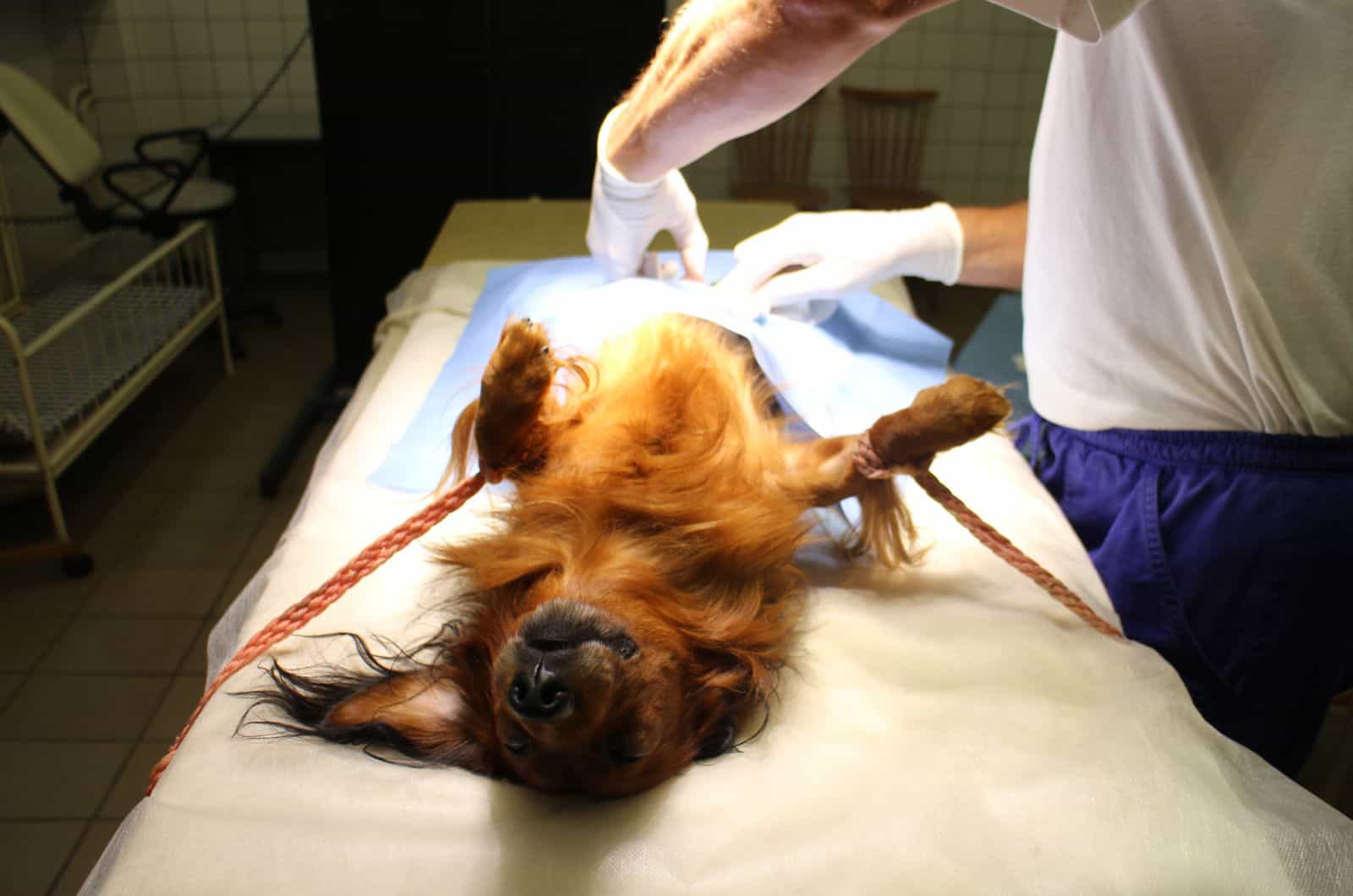
Sterilization minimizes the sexual urge in male dogs. So, when you neuter your male you will see a drastically reduced behavior like running away from home and portaging after females, or peeing down every pole during a walk.
In addition, you will be sure that your dog will not get testicular cancer.
Furthermore, neutering can significantly reduce both aggressive or dominant behavior in male dogs.
Neutering does not mean that a male dog will stop jumping on females or following their scent. Therefore, the sexual drive in a male dog will not disappear with neutering.
Castration should not be performed while the dog is still very young. The ideal age to neuter a dog will depend on the dog breed, size, and general health. Your veterinarian will best advise you on the best age to neuter your dog.
Consequences Of Neutering
In some cases, neutering can cause excess weight in the dog. Also, some dog breeds are otherwise prone to obesity, so they need special attention.
More than ever, take care of your dog’s diet after sterilization. In addition to diet, it is crucial that the dog gets enough exercise every day.
In some dogs, it is possible to notice that their fur is different after sterilization, and this phenomenon is most noticeable in dogs with long hair.
There is also a possibility that the dog will be frightened or sensitive after sterilization. It is important that the dog owner shows remarkable patience and care for his dog during this period, to return to normal as soon as possible.
When Will Dog Recover From Neutering?
If you are a dog owner who is thinking about neutering, your first question must have been: How long will my dog be in pain after neutering?
Although this may sound like a scary procedure to you, neutering is actually a routine procedure that is quite common in dogs. Of course, no procedure performed under general anesthesia is harmless and should be taken seriously.
After surgery, vets prescribe painkillers for the dog. After neutering, the dog should rest as much as possible and not be too active.
The dog will probably be in pain for a few days after the procedure. Apart from the noticeable pain, there is a high possibility that the dog will refuse to eat and will want to be alone. Each dog’s recovery will be different, but in general, the dog should not be in pain 10 days after surgery.
If you notice that the dog is still in pain, even though more than 10 or 15 days have passed since the operation, or if you notice swollen scrotum in your dog, you should contact the veterinarian immediately.
Finally, neutering has many benefits and can positively affect your dog’s behavior. However, it is up to each dog owner to decide if they want their pet to undergo this procedure.
Final Words
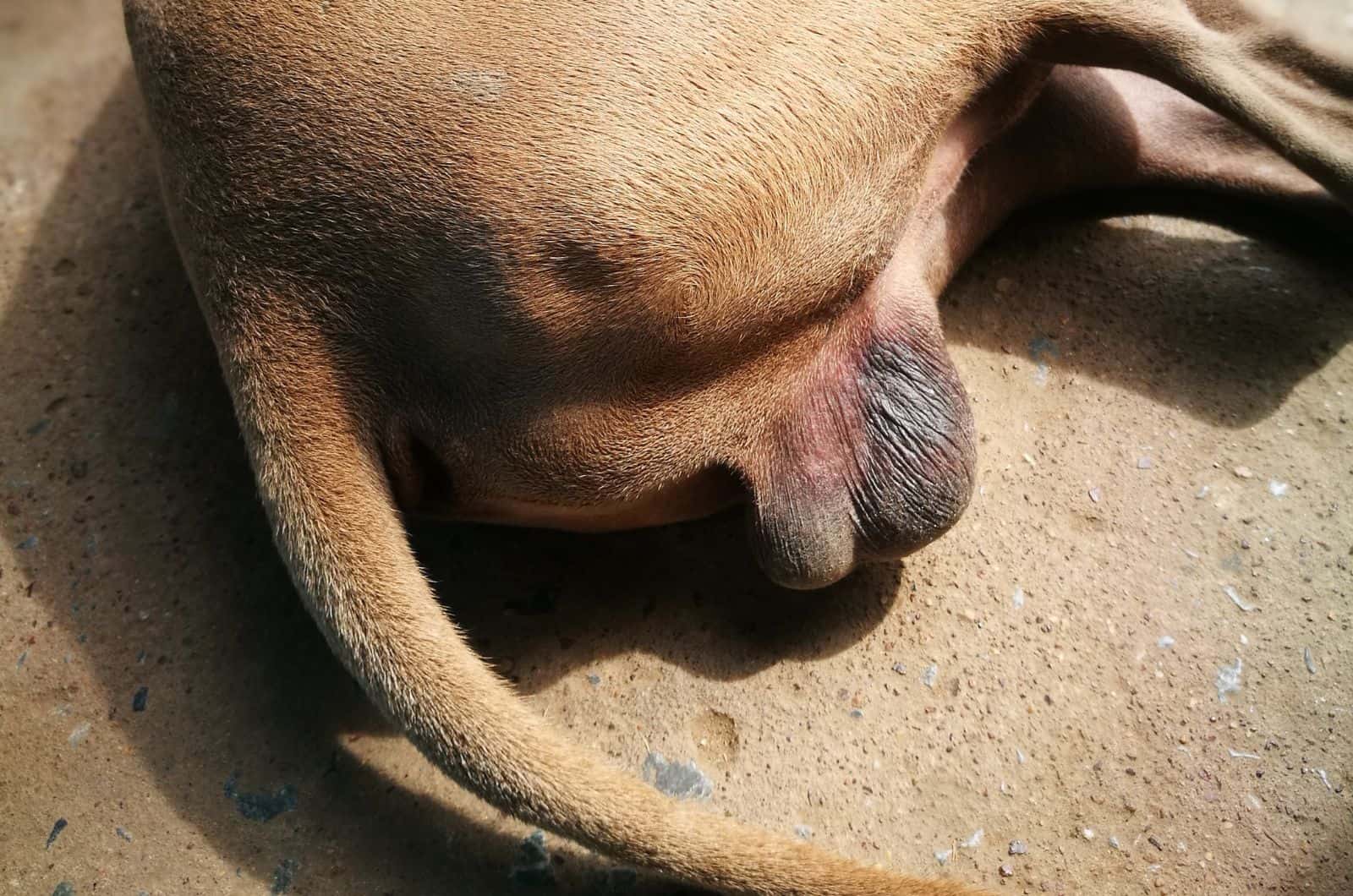
We hope that reading this article gives you an answer to the question of why your dog’s balls are red.
A dog’s testicles can turn red for a variety of reasons. Some are harmless, and some may point to more severe health conditions.
In any case, this is not a pretty sight and any dog owner will probably be instantly worried. However, there are better responses to a found problem than panicking.
Analyze your furry friend’s behavior and watch for any other symptoms. You can start taking concrete action when you have studied the situation in detail.
You will find the right solution to your concern at the veterinary office.
Ultimately, don’t worry immediately, but believe that everything will be excellent with your favorite pet!
Read Next:
• Why Is My Dog Licking His Butt? The Cause And The Cure
• Why Does My Dog Eat My Underwear? 12 Reasons And 7 Solutions












